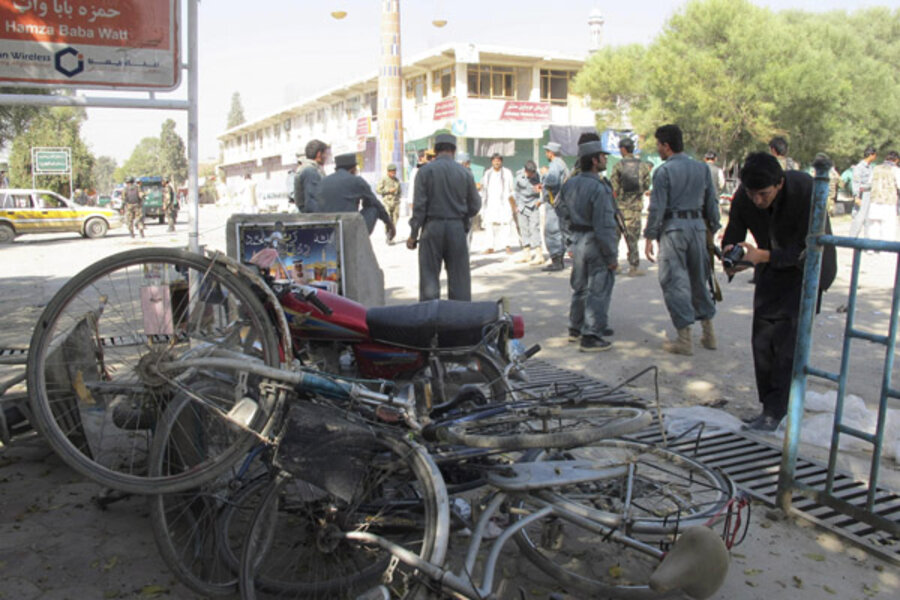Another insider? Uniformed Afghan suicide bomber kills 14
Loading...
A Taliban-claimed suicide attack killed 14 people – including 3 NATO soldiers – and injured 37 civilians in eastern Afghanistan following a weekend in which the US death toll in the conflict surpassed the 2,000 mark and continued to raise concerns over "insider" attacks by Afghan forces on Western troops.
Reuters reports that the suicide bomber struck Monday during a NATO patrol in the eastern city of Khost. In addition to the three soldiers killed, four police, an Afghan interpreter, and six civilians died in the blast. At least 37 civilians were injured, according to Provincial Governor Abdul Jabar Nahimi.
A witness told Reuters that the suicide bomber was wearing a police officer's uniform when he detonated his explosive-laden motorcycle. The witness said that a patrol of US soldiers was in the vicinity at the time. A NATO spokesperson would only confirm that there had been a suicide bombing.
Reuters notes that while the Afghan Taliban claimed responsibility for the bombing, the group is quick to claim any attack that results in the deaths of foreign soldiers.
The attack comes just two days after the 2,000th American died in Afghanistan in a clash between US and Afghan soldiers southwest of Kabul. The attack, which appears to have been the result of a misunderstanding after a US patrol was fired upon, ended in the deaths of two Americans – a soldier and a civilian contractor – and three Afghans. The New York Times reports that while initially described as a "green-on-blue" insider attack, the incident may have been a more traditional friendly-fire episode.
Shahidullah Shahid, the spokesman for the governor in Wardak Province, where the fighting occurred, said the deaths came “after a clash ensued between two sides following a misunderstanding.” An Afghan official, speaking anonymously because he was not authorized to release details, said that a mortar shell had landed amid the American unit, killing a soldier and a civilian contractor and wounding several others. The Americans thought it came from a nearby Afghan National Army checkpoint on a hill overhead and attacked it with small arms and rockets, killing three and wounding three of the seven soldiers there, the official said.
The Wardak provincial police chief, Abdul Qayoum Baqizoi, said the fight broke out when an Afghan soldier among seven soldiers at the checkpoint opened fire on the Americans; in the ensuing gun battle, three Afghan soldiers were killed, including the one who fired first. “We still don’t have a clear picture of what happened,” Mr. Baqizoi said. He quoted the lone Afghan soldier who was unhurt as saying, “ ‘I heard some noise and verbal argument and suddenly heard the shooting and then one of the coalition soldiers threw a hand grenade so I fled from the check post and hid myself behind our Humvee.’ ”
The Times notes that the US unit was small and not partnered with any Afghan forces, which may have exacerbated the confusion.
Regardless of the nature of Saturday's incident, it comes amid a recent spate of insider attacks that have raised public concerns over US and NATO partnerships with locals in Afghanistan. The Christian Science Monitor reported yesterday that while the US has seen a consistent drop in the rate of fatalities starting last year, attacks by Afghan soldiers and police on NATO forces have become a high-profile problem with no obvious solution.
“It gets at the very core of trust between coalition forces and the Afghans, and it’s very difficult to counter,” says David Barno, a senior fellow at the Center for a New American Security who commanded US and international forces in Afghanistan from 2003 to 2005.
Citing findings that show insurgent infiltration accounts for only a quarter of insider attacks, with personal disputes accounting for another quarter and the rest having unclear motivations, Mr. Barno says stopping the attacks will be difficult.
“You can come up with a counter-intelligence program and take a number of other measures to help find Taliban infiltrators, but if three out of four attacks are related to cultural misunderstandings, outbursts, or friction perhaps related to 11 years of exposure between the coalition and Afghans that’s much more perplexing and much more difficult to deal with,” he says.
In an interview with 60 Minutes recorded before Monday's attack, Gen. John Allen, the top US commander in Afghanistan, expressed his frustration about insider attacks and warned that more should be expected.
Lara Logan: You're in a tough spot right now. Can you explain why the sudden increase in these attacks?
Allen: Well, I'm mad as hell about them, to be honest with you. We're going to get after this. It reverberates everywhere, across the United States. You know, we're willing to sacrifice a lot for this campaign. But we're not willing to be murdered for it.
Lara Logan: At a certain point, if these attacks continue, the American people are going to say, "We've had enough." Right? "Why are we training these people if they're murdering us?"
Allen: Well, that may be, in fact. It may be the voice right now that we're hearing. The key point is for us to understand that the vast majority, the vast majority of the Afghans, and you've lived with them, you understand these people, they're with us in this. They understand right now the severity of this problem and the urgency of what's happening. And there have been Afghans who've been killed trying to save our forces when these attacks have been underway. Because that was the only reaction that they could've taken, was to try to save us at that moment of attack. ...
Lara Logan: Should Americans brace themselves for more attacks? Is this going to continue?
Allen: It will. The enemy recognizes this is a vulnerability. You know, in Iraq, the signature weapon system that we hadn't seen before was the IED. We had to adjust to that. Here, I think the signature attack that we're beginning to see the – is going to be the insider attack.








